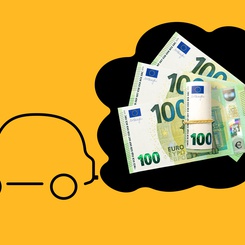With Ivana Ljubic and Claudia Archetti and Laurent Alfandari
E-commerce is now part of the consumer experience – why brave a busy mall when you could get your shopping delivered to your doorstep, and return it for free if you don’t like it? This trend has exploded: in the US, e-commerce consumer spending is projected to reach one trillion USD (1), and in China, over 40 billion packages were delivered in 2017 (2). While undeniably practical for the consumer, this presents challenges for the companies and for the environment, since consumers expect fast delivery and this can be a costly process. This results in an abundance of commercial vehicles traveling to make home deliveries: an unsustainable system both in terms of feasibility and environmental impact. These commercial vehicles add to pollution and traffic congestion. ESSEC professors Diego Delle Donne, Laurent Alfandari, Claudia Archetti and Ivana Ljubic, all from the Department of Information Systems, Decision Sciences and Statistics, are exploring the challenges of delivery logistics in an ongoing research program. They’ve explored the challenges of last-mile delivery (the last leg of the distribution process) and how emerging technologies, including AI, can play a role in reducing the pollution caused by urban freight transportation. In their latest paper published in Transportation Research Part B (3), they explore the possibility of using “freight-on-transit” delivery methods: using public transportation to transport packages in big cities.
Various solutions have been trialed to face the challenges, related to reduce the cost and environmental impact associated with e-commerce and especially last-mile delivery:
- Pickup points: a widely used solution in France, where you can pick up your package at your local boulangerie or flower shop, as long as the store is a partner,
- The use of drones or self-driving autonomous robots, or
- Crowd-shipping apps (leveraging networks of local, non-professional couriers to deliver packages to customers' doors).
However, none of these solutions have quite managed to reduce the traffic load on last-mile deliveries, nor reduce the environmental impact from the emissions. With e-commerce showing no signs of slowing down, the researchers decided to explore alternative options. One such option is the use of public transport, since consumers are concentrated in urban areas. They looked at the viability of using public transport lines, specifically during non-peak hours, during which there’s space to spare onboard.
This idea has already been tested. Pilot projects are ongoing in Karlsruhe, Germany, and in London. In France, Monoprix used the RER D to transport products between their suburban distribution center and Bercy station in Paris (albeit not for customers’ home grocery delivery). In Canada and the USA, Greyhound uses passenger buses to deliver packages. These projects have seen early success, providing initial support for the concept’s feasibility.
The researchers identified three types of decisions to consider: strategic, tactical, and operational.
Strategic decisions include:
- The type of transport to use (bus, tram, metro) and which lines
- Where to place the pick-up and drop-off points
- The objectives: number of packages delivered, cost reduction…
Tactical decisions include:
- Whether to use lockers (so that consumers pick up from those) or deliver right to the final destination
- In case of the latter, the type of fleet to use for the last-mile delivery: couriers on foot, bicycle or scooter, robots, autonomous vehicles…
- The size of the fleet
Operational decisions include:
- Daily schedules, routing of packages
- Available time windows
- How to optimize the cost/distance trade-off
In their latest publication, the researchers explored strategic decisions involved in using freight-on-transit for last-mile deliveries, specifically looking at the choice of transport lines and stations to use for delivery purposes.
They looked at a model where packages go from their origin points (Central Distribution Centers) to their destinations (customers), using public transport. First, packages are transported from their origin to public transport stations, then loaded onto the vehicle (be it bus, train, or tram). Then, they are transported to their ‘drop-out’ station and picked up by freighters (porters, drones, etc.) who cover the last mile and take them to the customer.
This figure illustrates the stages of a Freight-on-Transit system.
These kinds of decisions involve both public authorities, who manage public transport, and private companies, who are responsible for the deliveries. As such, freight-on-transport systems involve agreements between the two types of stakeholders.
In their model, the researchers conducted a case study using the city of Orléans, France, as an example. Currently, Orléans has 90 bus lines, and each line has around 23 stops. They used mathematical modeling (based on Integer Programming formulations) to assess the available budget and the bus system’s capacity to answer strategic decision questions such as: which bus lines should be involved and where the “drop-in” and “drop-off” stops should be located. Their model took into account the packages’ origins and destinations, the available lines, the potential “drop-in” and “drop-off” stops, each line’s package capacity, and the costs involved. Costs can include buying storage equipment and time for loading/unloading packages. The use of this kind of model can help stakeholders to figure out the best system for using freight-on-transit in their city. By doing so, stakeholders can reap the advantages of freight-on-transit: an option worth considering given the ubiquity of e-commerce and its associated societal, financial, and environmental costs. The researchers are also exploring tactical decisions and operational decisions in ongoing research projects to better understand how to optimize the use of public transport for package delivery and identify better solutions for last-mile delivery.
Advantages of using public transport for delivery include:
- A win-win situation for major stakeholders, since public authorities can reduce the environmental impact of deliveries and create a more sustainable city, and logistics companies can reduce their costs;
- A way to adapt to regulations on commercial vehicles in urban areas;
- Improving customer satisfaction by ensuring quick delivery while reducing the load on commercial fleets.
Freight-on-transit concerns city planners, transport authorities, local governments, e-commerce companies, environmental activities, and even individual consumers. It is a practical option worth considering, since online ordering is not going away anytime soon and protecting our environment is an ongoing team effort. Research on alternative and hopefully greener solutions can help stakeholders to figure out the best solution for package delivery in their urban area, which could improve the city’s livability and sustainability.
References
-
Reuters, 2022. U.S. Consumers to Spend Record $1 Trillion Online in 2022 - Report. Reuters, URL https://www.reuters.com/world/us/us-consumers-spendrecord-
-
National Bureau of Statistics of China, 2020. National Data. National Bureau of Statistics Beijing, http://www.stats.gov.cn/.
-
Delle Donne, D., Alfandari, L., Archetti, C., & Ljubić, I. (2023). Freight-on-Transit for urban last-mile deliveries: A Strategic Planning Approach. Transportation Research Part B: Methodological, 169, 53-81.
This work was funded by CY Initiative of Excellence, France (grant “Investissements d’Avenir” ANR-16-IDEX-0008”).









